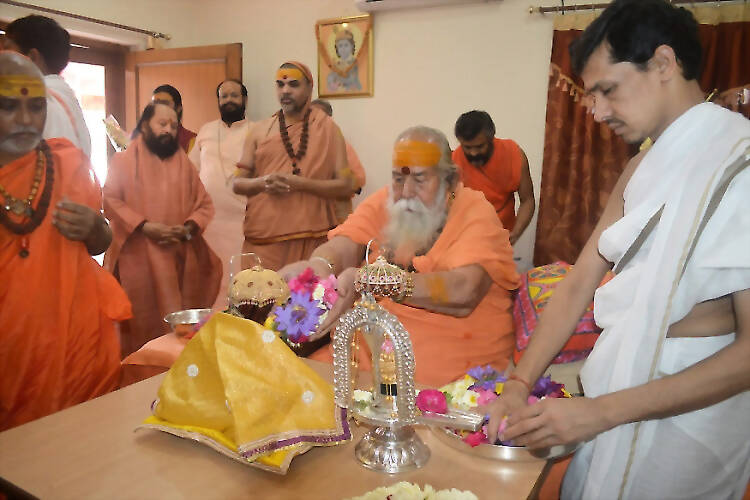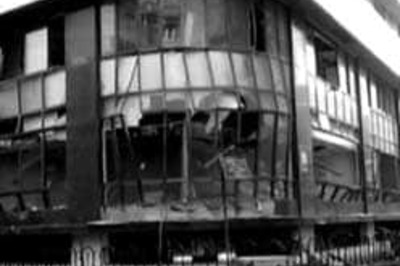
views
Was it pressure from Swami Swaroopananda Saraswati, Shankaracharya of Dwarka Peeth, nicknamed the “Congress Swami” that prompted the Vishwa Hindu Parishad not to hold any agitation on the Ram Janmabhoomi issue for the next four months until the Lok Sabha elections are over?
Swami Swaroopananda, currently camping at Prayagraj’s Kumbh Mela, had announced he would lead a march to Ayodhya on February 10, ostensibly to lay the foundation stone for Ram Temple construction on February 21.
His gusto had sought to overshadow the VHP and its Dharma Sansad at Prayagraj which has failed to announce any specific date for Ram Temple construction, triggering protests from large sections of Hindu sadhus and saints. Some disgruntled men of religion now wonder why the VHP-RSS had been raising the war cry of “mandir waheen banayenge” without any time-table.
VHP insiders say there were a number of factors that worked to dissuade the Dharma Sansad to put Ayodhya agitation on the backburner. Firstly, Prime Minister Narendra Modi and the ruling NDA was unwilling to back the VHP when Ramjanambhoomi-Babri masjid dispute is in the Supreme Court.
Secondly, political feedback was that that Ram temple issue was not attracting voters - particularly first time voters born after 1992. In such a grim scenario, the VHP reportedly felt that it was not in the position to take on Swami Swaroopananda. A retreat became inevitable.
Interestingly, this is not for the first time that Swaroopananda, with the tag of “Congress Swami”, is being proactive on Ayodhya front. In February 2002, Swaroopnanda had encouraged Sonia Gandhi to take on the Hindutva forces on the contentious Ram temple issue. The Congress president had then shared a platform with three Shankaracharyas at Dighauri in Madhya Pradesh to take an independent line on the Ayodhya dispute.
The Dighauri conclave, a brainchild of the then Madhya Pradesh chief minister Digvijay Singh, was aimed at breaking the VHP’s hegemony over the Ram temple movement. Singh, with the help of Swaroopananda, had roped in the highly-respected Shankaracharya of Kanchi Kamakoti Peeth, Swami Jayendra Saraswati and his Puri counterpart, Swami Nishchalananda.
In Congress’ scheme of things then and perhaps even now, if the court rules in favour of a Ram temple at the disputed site in Ayodhya, the Ramalaya Trust, headed by Swami Swaroopananda, should be in charge of its construction instead of the Vishwa Hindu Parishad.
The Dighauri Dharma Sansad of 2002 had also tried to resolve the Ayodhya dispute through a peaceful consensus after consulting Muslim religious leaders. However, prominent Muslim leaders and organizations involved with the Babri dispute had declined to attend the meet.
Sonia’s visit at Dighauri had caused considerable uneasiness within the Congress. Some Congress Working Committee members had initially sought to caution her against taking part, but she countered the argument by asserting that the party should not shy away from taking a stand on the vexed issue.
Sonia had even told CWC members that she decided to play an active role in the debate after realizing that the Congress would continue to be irrelevant in Uttar Pradesh till it took a firm stand on Ayodhya dispute. “We are saying that we will abide by the court verdict. We are also saying that in case the majority community gets the legal mandate to construct the temple, the Ramalaya trust should build the temple instead of the VHP,” a top Congress functionary had quoted her as saying.

Swami Swaroopananda Saraswati had announced he would lead a march to Ayodhya on February 10.
Sonia’s stand had upset Prime Minister Atal Bihari Vajpayee too. Reacting angrily to her proximity with the Shankaracharyas on Ram Temple issue, Vajpayee chose to speak about it in the Lok Sabha on the vote of thanks to the Presidential address. He wondered why he was being criticized for holding parleys with the VHP sants when Sonia had bowed before the Shankaracharyas.
“If she takes Shankaracharya’s blessings, why should I be deprived of getting blessed by Mahant Ramchandra Paramhans?” Vajpayee had quipped. Ramchandra Paramhans, who died in 2003 at the age of 90, was head of the Ramjanmabhoomi Nyas (the Rama Birthplace Temple Trust). He led the battle for a Ram temple for more than 70 years.
The seer from Dhigouri in Seoni, Madhya Pradesh has been a consistent and fierce opponent of the VHP, RSS and the BJP. Swaroopananda has been a vocal campaigner for the Congress in elections and on most issues close to the grand old party’s heart.
In January 2001, when Sonia Gandhi, facing opposition on grounds of her foreign origins, took a holy dip at Allahabad during the Kumbh Mela, Swaroopananda had famously declared, “She is every inch an Indian,” while defending her right to be PM.
Swaroopananda, 94, heads several religious bodies such as the Ramrajya Parishad, the Ramalaya Trust and the Ram Janma Bhumi Nyas — not the same as the one led by VHP and Paramhans.
Among other things, Swaroopananda, says he is gender-sensitive. He says he set up the Akhil Bharti Ubhay Bharti Mahila Ashram in Bengal in 1993 to “honour” women by making them proficient in shaastraarth (verbal duel in religious matters), a male domain.
Controversies come easily to Swaroopananda. In 2010, he had described himself as “supreme court of Hindus.”
The burly Swami was at the loggerheads with Madhya Pradesh’s then state environment and forest minister Sartaj Singh for not letting him construct a boundary wall and a gate near Sankal Ghat cave in Narsingpur district, situated in central part of Madhya Pradesh. According to Swaroopananda, the cave was sacred as Adi Guru Shankracharya said to have lived and meditated inside.
Sartaj, enjoying BJP chief minister Shivraj Singh Chouhan’s confidence then, initially showed scant regard for Swaroopananda. He kept saying that the area around the cave belonged to a forest reserve as per law, and he could not grant it on lease to a trust headed by Swaroopananda. Dwarka Shankaracharya then camped in Bhopal for a week constantly accusing Shivraj Singh Chauhan regime of being ‘anti-Hindus.’
Swaroopananda claimed that under BJP rule, cows were getting illegally slaughtered and buffalo meat from the state was being exported in large quantities.
To Sartaj-Chouhan’s surprise, some of his ministerial colleagues turned out to be Swaroopananda’s devotees and mounted pressure on him to soften the stand. Sartaj finally went to see Swaroopananda expressing his department’s inability to grant forestland in view of stringent Supreme Court guidelines.
The Shankaracharya was reportedly incensed over a reference to the apex court and curtly pointed to the BJP minister if he had any regard for Shankaracharya whom he described as “supreme court of Hindus.” Sartaj said he had ‘highest regards’ for religious leaders including Shankaracharya promising to “do the needful.”
The state minister said to have also agreed that in the event of central agencies or the apex court raising any objection, his department would stoutly defend the grant of lease to Swaroopananda’s trust.
(The author is visiting fellow at the Observer Research Foundation and a senior journalist. Views are personal)


















Comments
0 comment